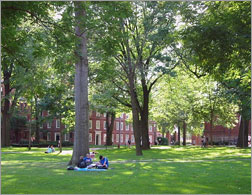
That's where America's greatest university is investing its endowment?
By Daniel Gross
Posted Monday, Nov. 17, 2008, at 7:03 PM ET
The recent market turmoil portends hard times for even the wealthiest universities. Last week, Harvard President Drew Gilpin Faust told stakeholders that, with the research service Moody's projecting "a 30 percent decline in the value of college and university endowments in the current fiscal year," Harvard needs "to be prepared to absorb unprecedented endowment losses and plan for a period of greater financial constraint."
If any investor could have avoided the credit catastrophe, it should have been Harvard. Harvard, the ultimate long-term investor (it's been compounding assets for more than 350 years), sports the nation's leading business school and counts a host of financial geniuses among its many distinguished alumni. But judging by one snapshot of a portion of Harvard's gigantic endowment, Harvard's recent financial performance is less than impressive.
The Harvard Management Company has the enviable but challenging task of managing Harvard's mammoth endowment. As of June 30, 2008, HMC managed more than $45 billion, the vast majority of it endowment assets. (Here's HMC's annual report and data on its impressive recent performance.) HMC parcels out big chunks of the endowment to outside managers—hedge funds, private-equity firms, asset managers of all stripes—and its staff manages a large chunk itself.
Much of the granular data on who manages what and how much Harvard has invested in which assets aren't publicly available. But every quarter, HMC files a 13-F form with the Securities and Exchange Commission, indicating a portion of its holdings in publicly traded securities—stocks, bonds, exchange-traded funds. The 13-F is a snapshot and is not fully representative of Harvard's overall holdings. But the chunk of the portfolio revealed in the most recent 13-F looks like it was chosen by someone who watched a few episodes of CNBC's Squawk Box and heard that the hot new investments were emerging markets, commodities, and private equity.
The 13-F shows Harvard with some 231 positions worth nearly $2.9 billion, highly concentrated in popped macroeconomic bubble plays. The top 10 holdings, which Bloomberg helpfully breaks out, account for 70 percent of the value of the disclosed holdings. Virtually all of them performed rather poorly in the third quarter, and virtually all of them have slid in the weeks since Sept. 30.
The biggest position disclosed—all amounts and dollar values are as of Sept. 30—was $463 million in the iShares MSCI Emerging Market fund. As the six-month chart shows, that fund's off nearly 60 percent from this summer and down by about one-third from the end of September. Third-largest was a $233 million position in Weyerhauser, the wood-products giant that has fallen about 40 percent since the end of September. The top 10 included $232 million in the iShares MSCI Brazil Index Fund, off about 40 percent since the end of September; about $51 million in the iPATH MSCI India Index, off about one-third since the end of September; and $158 million in the iShares FTSE/Xinhua China Index, off about 30 percent since the end of September. For good measure, top 10 holdings also included index funds that were plays on South Africa's commodity-based economy and on the perennially emerging market of Mexico. Would it surprise you to learn that both of those investments, after fairing poorly in the third quarter, have fallen further in the fourth quarter?
Now, this emerging-market-heavy filing is clearly not representative of Harvard's overall asset-management strategy. As HMC's asset-allocations data show, the endowment allocated about 11 percent of its total to emerging market stocks. (By contrast, nearly half of the portfolio described in HMC's 13-F was in emerging market stocks.) But it does show that even the best, most experienced, and highly regarded long-term investors can get suckered into new-era thinking and make investments that turn out to be highly risky bets. The 13-F shows that the managers running this Harvard porfolio were huge believers in the decoupling theory—i.e., that emerging markets would continue to thrive even as the United States stalled—and in the notion that commodities would keep booming.
Why did this belief persist for so long? The answer would make a great Harvard Business School case study.
Daniel Gross is the Moneybox columnist for Slate and the business columnist for Newsweek. You can e-mail him at moneybox@slate.com. He is the author of Pop! Why Bubbles Are Great for the Economy.
Article URL: http://www.slate.com/id/2204827/
Copyright 2008 Washingtonpost.Newsweek Interactive Co. LLC

Comment